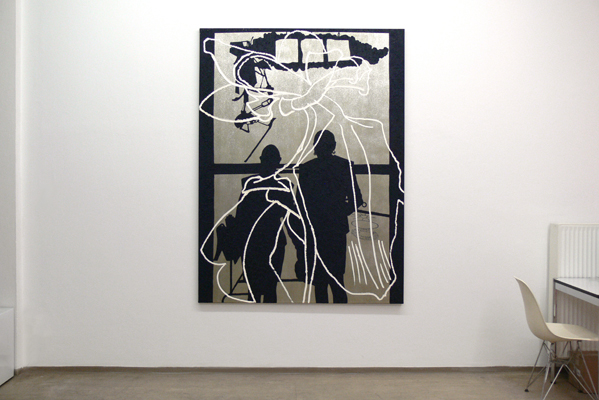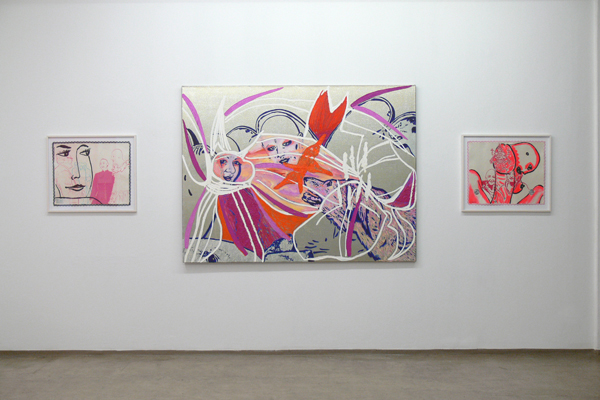|
EVA & ADELE: KEEP THE ROSY WING STRONG
Opening reception for the artists: November 11, 2021, 6 pm
Exhibition: November 12, 2021 - January 22, 2022

TO THE VIRTUAL EXHIBITION
Please scroll down for the English version.
Mit zwei großen Ölbildern der Serie Time Traveler CUM, 19 Gouachen der Serie CUM und den Polaroids der Serie CUM als Wallpaper, zeigt die Nicole Gnesa Galerie in der fünften gemeinsamen Ausstellung KEEP THE ROSY WING STRONG Arbeiten aus dem wichtigsten Werkkomplex des Künstlerduos EVA & ADELE.
CUM und Camp
Die Serie CUM ist das Herzstück ihrer künstlerisch, konzeptionellen Arbeitsweise. Wo EVA & ADELE auftreten, lösen sie Bilder aus. Wenn EVA & ADELE als identisch, weibliches Paar wie Pop-Ikonen Postkarten verteilen, Autogramme geben und sich wie Stars fotografieren lassen, ist „Staring“ Teil ihres Werkes.
AusstellungsbesucherInnen in Japan, PolizistInnen in Miami oder PassantInnen auf den Straßen von Berlin – alle wollen sich mit ihnen ablichten lassen. Die Fotografien lassen sich EVA & ADELE zusenden und machen sie zur motivischen Grundlage der Malerei ihrer Werkreihe CUM. Die Dokumentation ihrer Auftritte wird damit an den Betrachter delegiert, und dieser wird gleichzeitig aktiv in das Werk einbezogen. Ihr Statement WHEREVER WE ARE IS MUSEUM verdeutlicht es.
Mit dem „Posing“ und der extremen Farbgebung wie Rosa, Orange und Rot - einem Markenzeichen der Kleidung und Kunstwerke des Künstlerinnenduos - arbeiten sie bewußt mit Elementen des Kitsch beziehungsweise von „Camp“, einem Begriff der Kulturgeschichte, den die Kritikerin Susan Sontag (1962) in die Kunsttheorie eingeführt hatte. Zudem bedeutet im französischen Sprachraum das Verb „se camper“, „sich in Szene setzen“ oder „posieren“.
„Camp“ kommt schrill daher, bedient sich aber Mitteln, die schwergewichtig gesellschaftlich relevante Modelle in Frage stellen. Wie Judith Butler (1988) erläuterte, dass es bei „Camp“ um das Hinterfragen von kulturell konstruierten Geschlechtern geht als Parodie und Übertreibung. Es handelt sich also um ein Phänomen, das sich der Trennung zwischen den beiden Kategorien „Mann“ und „Frau“ annimmt. „Camp“ stilisiert die Frage des sozialen Geschlechts dabei zu einer Frage der Ästhetik. Die Frage der Ästhetik der Existenz, in der Kunst und Leben konsequent gleichgesetzt sind, sind das die wichtigsten Parameter im Werk von EVA & ADELE.
Gouachen
Die 19 Gouachen mit Titeln wie CUM Mythologisch Chimära (1998/2008) und CUM Mythologisch Shiwa als Schildkröte (1998/2008) sind Ausdruck ihres geistigen Kosmos. Mit ihren jüngeren Überarbeitungen der Papierarbeiten von 2008 beleben EVA & ADELE die Serie. Motive u.a. aus der antik-römischen wie auch der indischen Mythologie sind wie Motoren im Getriebe der Geschichte zu verstehen, die sie als Impulsgeber aus der Vergangenheit für die Gegenwart aktivieren. Sie dehnen die Mythen aus der früheren Ideengeschichte bis in die Gegenwart hinein über Jahrtausende hinweg aus, verankern ihre Werte und Sinnstrukturen in der Zukunft, wie EVA & ADELE es für das FUTURING einfordern.
Ölbilder und Time Traveling
Das zentrale Werk der Ausstellung Time Traveler CUM No 231 (1998/2018 s. unten) zeigt EVA & ADELE wie im Schatten vor einer der wichtigsten Arbeiten des 20. Jahrhunderts. Dieses Ölbild der Time Traveler CUM-Serie bezieht sich auf eine Performance des Künstlerpaars im Jahr 1992 vor Marcel Duchamps Werk das Große Glas (La Mariée mise à nu par ses célibataires, même, 1915-23) im Philadelphia Museum of Art, zu dem sie im Zuge einer New York Reise extra gepilgert waren.
Duchamps bis heute rätselhaftes Werk gibt gleichsam Hinweise und ist gedanklicher Impulsgeber für den umfassend, konzeptionell angelegten Werkbegriff des Performance-Duos EVA & ADELE: Denn der französische Künstler gilt als der Wegbereiter des erweiterten Kunstbegriffs, indem er u.a. Zufall, Mechanik als auch Erotik mit in seine Kunst einbezog.
Wie keine andere Arbeit von Duchamp, wirft die Skulptur das Große Glas einen enormen Schatten auf die Kunst des 20. und 21. Jahrhunderts, in dessen Magie sich EVA & ADELE behaupten - vielleicht ausgedrückt durch den silbergrauen Glitzerstaub im Bild. In der Arbeit geht es um die erotische Begegnung zwischen der 'Braut' in der oberen Platte, und unten, ihren neun ‚Bräutigammen‘, die in einer Fülle von mysteriösen, mechanischen Vorrichtungen versammelt sind.
Als zeitgenössischen Neubeginn zu verstehen, starteten EVA & ADELE 1991 ihre künstlerische Doppelexistenz, durch eine Hochzeitsperformance. Mit diesem Auftritt legten sie ihre bisherig individuellen Existenzen ab.
Duchamp arbeitete prozessual und zeitbasiert. Virulent ist, dass Duchamp als derjenige gilt, der das Tafelbild abschaffte und nun aber in der Malerei von EVA & ADELE wieder firmiert. Das ist konsequent, denn jedes Öl-Bild der Time Traveler CUM-Serie wie auch die Guachen der CUM-Serie sind nicht als gemalte Bilder zu verstehen, sondern als weitergeführte Performances, indem sie jeweils vom Foto in Malerei und wieder durch Überarbeitung die Performance weiterführen.
Denn diese ursprüngliche Performance des Duos in der Duchamp Ausstellung haben EVA & ADELE 2018 weitergeführt, indem sie dem Bild mit einer weißen, stilisierten Blütenzeichnung eine weitere Ebene setzen. Vielleicht deutet das Motiv der frischen Blüten, das ein fest eingeschriebener Topos für Jugend und Lebenskraft in der Kunstgeschichte ist, auch auf die Aktualität der mit Duchamp verbundenen Sinnebenen hin.
Die Überarbeitung deutet auf eine Time Traveler-Aktualisierung des Duchampschen Konzepts hin, das für fliessende Übergange von männlicher und weiblicher Existenz steht. Rrose Sélavy war das berühmte weibliche alter ego von Marcel Duchamp.
EVA & ADELE arbeiten permanent an den gesellschaftlichen Parametern, dass physische Merkmale wie Geschlecht lediglich konstruiert sind und überwindbar, die Identität letztlich gesellschaftliches Konstrukt ist. Die künstlerische Konzeption bietet eine Möglichkeit der Identitätsgestaltung über Grenzen der traditionellen Rollenverteilung und des heteronormen Geschlechterverständnisses hinweg, hin zu einer offenen Gesellschaft, in der fluide Geschlechtergrenzen Teil sind.
Zudem verdeutlicht die Mitarbeit der Fotografierenden in den CUM-Serien von EVA & ADELE die wichtige Strategie der Dekonstruktion und Überwindung von Autorschaft.
Text by Dr. Heike Fuhlbrügge
Zur Ausstellung erscheint eine gleichnamige Publikation mit Abbildungen aller Arbeiten der CUM-Serien im Hirmer Verlag.

With two large oil paintings of the series Time Traveler CUM, 19 gouaches of the series CUM and the Polaroids of the series CUM as wallpaper, Nicole Gnesa Galerie shows in its fifth EVA & ADELE exhibition KEEP THE ROSY WING STRONG works from their most important work complex.
CUM and Camp
The CUM series is the centrepiece of their artistic, conceptual way of working. Wherever EVA & ADELE appear, they trigger images. When EVA & ADELE, as an identical, female couple, hand out postcards like pop icons, sign autographs and let themselves getting photographed like stars, "staring" is part of their work.
Exhibition visitors in Japan, police officers in Miami or passers-by on the streets of Berlin – they all want to be photographed with them. EVA & ADELE have the photographs sent to them and make them the motivic basis for the paintings in their series CUM. The documentation of their appearances is thus delegated to the viewer, who is at the same time actively involved in the work. Her statement WHEREVER WE ARE IS MUSEUM makes this clear.
With the "posing" and the extreme use of colours such as pink, orange and red - a trademark of the artist duo's clothing and artworks - they consciously work with elements of kitsch or "camp", a term in cultural history introduced into art theory by the critic Susan Sontag (1962). Moreover, in French the verb "se camper" means "to put oneself in the limelight" or "to pose".
"Camp" comes across as flashy, but uses means that heavily put socially relevant models in question. As Judith Butler (1988) explained, "camp" is about questioning culturally constructed gender as parody and exaggeration. It is thus a phenomenon that takes on the division between the two categories of "man" and "woman". "Camp" thereby stylises the question of social gender into a question of aesthetics. The question of the aesthetics of existence, in which art and life are consistently equated, they are the most important parameters in the work of EVA & ADELE.
Gouaches
The 19 gouaches with titles such as CUM Mythological Chimera (1998/2008) and CUM Mythological Shiwa as Turtle (1998/2008) are an expression of their spiritual cosmos.
With their more recent revisions of the paper works from 2008, EVA & ADELE enliven the series. Motifs from ancient Roman as well as Indian mythology, among others, are to be understood as the motors in the gears of history, which they activate as impulse generators from the past for the present. They extend the myths from the earlier history of ideas into the present and over millennia, and anchor their values and structures of meaning in the future, just as EVA & ADELE demand it for FUTURING.
Oil Paintings and Time Traveling
The central work of the exhibition Time Traveler CUM No 231 (1998/2018) shows EVA & ADELE as if standing in the shadow in front of one of the most important works of the 20th century. This oil painting in the Time Traveler CUM series refers to a 1992 performance by the artist couple in front of Marcel Duchamp's work The Large Glass (La Mariée mise à nu par ses célibataires, même, 1915-23) at the Philadelphia Museum of Art, to which they made an extra pilgrimage during a New York trip.
Duchamp's work, which remains enigmatic to this day, provides clues and is the intellectual impetus for the performance duo EVA & ADELE's comprehensive concept of their work: the French artist is regarded as the pioneer of the expanded concept of art by including chance, mechanics and eroticism in his art.
Like no other work by Duchamp, the sculpture The Large Glass casts an enormous shadow on the art of the 20th and 21st centuries, in whose magic EVA & ADELE assert themselves - perhaps expressed by the silver-grey glitter dust in the picture. The work is about the erotic encounter between the 'bride' in the top panel, and below, her nine 'grooms' gathered in a plethora of mysterious, mechanical contraptions.
To be understood as a contemporary new beginning, EVA & ADELE started their artistic double existence in 1991, through a wedding performance. With this performance, they shed their hitherto individual existences.
Duchamp worked processually and time-based. Virulently, Duchamp is considered to be the artist who abolished the panel painting, but now he reincarnates it in the painting of EVA & ADELE. This is consistent, because all oil paintings of the Time Traveler CUM series as well as the gouaches of the CUM series are not to be understood as painted pictures, but as continued performances, in that they each continue from the photograph into painting and again through reworking the performance.
In this original performance of the duo in the Duchamp exhibition, EVA & ADELE have continued in 2018 by adding another layer to the painting with a white, stylised flower drawing. Perhaps the motif of fresh blossoms, which is a firmly inscribed topos for youth and vitality in art history, also points to the topicality of the levels of meaning associated with Duchamp.
The revision hints to a Time Traveler update of Duchamp's concept, which stands for fluid transitions of masculine and feminine existence. Rrose Sélavy was Marcel Duchamp's famous female alter ego.
EVA & ADELE permanently work on the social parameters that physical characteristics such as gender are merely constructed and can be overcome, that identity is ultimately a social construct. The artistic conception offers a possibility of shaping identity beyond the boundaries of traditional role distribution and the heteronormative understanding of gender, towards an open society in which fluid gender boundaries are part of our society.
In addition, the cooperation of the photographers in the CUM series of EVA & ADELE illustrates the important strategy of deconstruction and overcoming of authorship.
Text by Dr. Heike Fuhlbrügge
A correspondent publication with images of all the works of the CUM series will be published by Hirmer Verlag to accompany the exhibition.


with the friendly support of // mit freundlicher Unterstützung von

|
|





